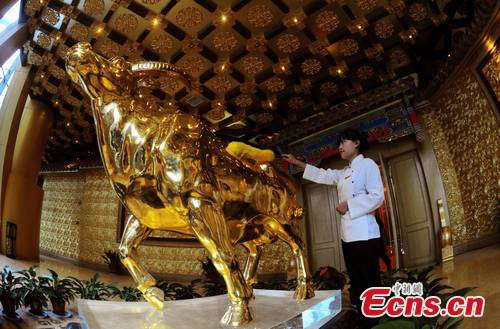(Ecns.cn)--Visitors to Huaxi Village are invariably astonished. If it's not the new 328-meter skyscraper, it's the one-ton fine gold bull at the sixtieth floor of the skyscraper worth of 400 million yuan (around U.S.$ 63 million) that sets jaws swinging.
Actually it is surprise enough to those familiar with rural China that villagers are driving good cards and living in villas. If you are willing to spend some extra money, you can even experience get a bird's-eye view of Huaxi Village from a helicopter.
Huaxi Village claims to be the richest village in China. Located in Jiangyin City, in east China's Jiangsu Province, the community is exploring tourism as a way to promote the new socialist countryside.
Seen from the outside, the village is an ideal place for peasants to reside, but inside, you have to wonder what kind of lives are being led.
Layers of collective economy
After half a century's development, Huaxi currently owns over 60 township enterprises with gross product over 50 billion yuan, reports the Zhengzhou Evening Paper. Since 2009 the village has seen orders decrease in its major steel, textile and chemical fiber plants. Huaxi has been working hard to carry forward an industry transition in recent years, putting tourism, finance and shipping into prominent positions in its planning.
Huaxi Village used to be a poor farming place, but explored its own route to prosperity by setting itself up as a model Chinese collective economy for a rural area. The village expanded from 0.92 square kilometers to 3.5 square kilometers in 2001 with a large-scale merger of 13 neighboring villages that left the original Huaxi as the center village.
People that live and work in Huaxi Village are categorized into three groups: the villagers of center village, the villagers of neighboring zones, and migrant workers. The three types of residents enjoy different levels of treatment with respect to the collective economy. The center villager is entitled to profit-sharing, while the villagers of neighboring zone are entitled to basic welfare and migrant workers live on wages.
A sample family's portfolio
Gong Qingfeng and his family are typical examples of well-off residents. At 35, he is a workshop director in a village textile factory. His wife works as an accountant here. They support his mother, a native villager incapable of working due to a leg condition. His father was not originally a Huaxi villager but his marriage gave him the status of a center villager.
The Gong family portfolio represents the three parts of the local economy: salary and bonus, welfare and profit sharing.
Besides the basic salary per month, in 2010 the Gong family bonuses amounted collectively to 480,000 yuan. The village encourages shareholders to reinvest their dividends in shares and just enjoy a modest bonus. So for the 2011 bonus, the Gong family took 97,000 yuan in cash and reinvested the other 80 percent.
Welfare contributes a small part to the family income. For example, one program allows the purchase of 150 kilograms of rice every year at the preferred price of two yuan per kilogram.
The Gongs took over a three floor European-styled villa in 2008 that cost them over two million yuan with a ten year mortgage. The family's yearly share of profits is just enough to meet the annual payment on the villa.
The center village is ensured of each villager's devotion by managing their shares and providing them the basis of a good lifestyle. According to the Huaxi Center Village Compact, once a center villager leaves, or no longer works or does business here, the village has the right to repossess the house, bonus, welfare rights and shares.
The three members of the Gong family trade their labor for the good life. They all have to work eight hours 7 days a week to hold down full time jobs in the township enterprise, with a short break of two days every year for Spring Festival.


















